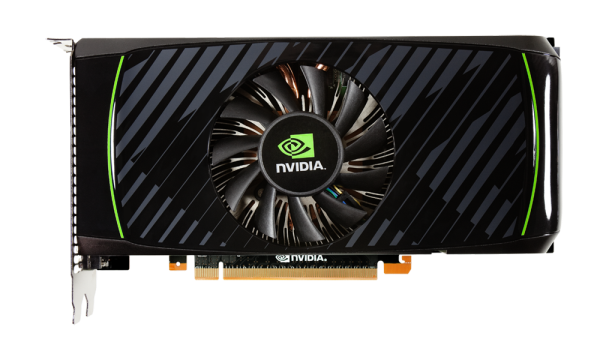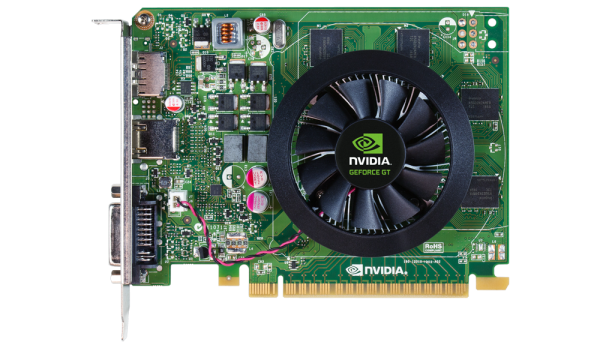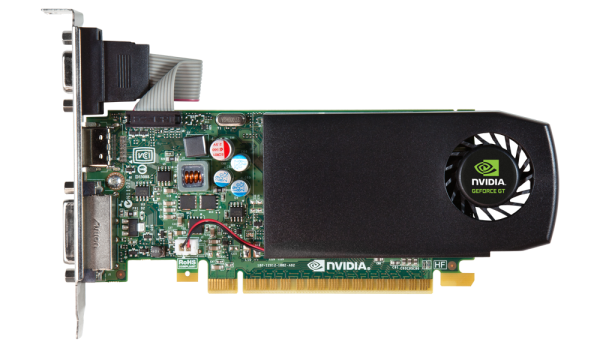NVIDIA Updates GeForce 600 OEM Desktop Lineup, Adds GT 645, GT 640, GT 630
by Ryan Smith on April 25, 2012 4:30 AM ESTWhile NVIDIA doesn’t publically announce most of their OEM desktop graphics cards, they do update their website with the specifications of these cards, which is how we usually find out about them. Today has been no exception, and after NVIDIA's latest site update a bit of digging has unearthed the fact that NVIDIA has released their first Kepler cards for the desktop market. There are 5 new OEM desktop cards, composing a mix of both Kepler and Fermi: the GT 645, the GT 640, and the GT 630.
| GT 645 | GT 640 | GT 640 | GT 640 | GT 630 | |
| Stream Processors | 288 | 384 | 144 | 384 | 192 |
| Texture Units | 48 | 32 | 24 | 32 | 16 |
| ROPs | 24 | 16 | 16 | 16 | 16 |
| Core Clock | 776MHz | 950MHz | 720MHz | 797MHz | 875MHz |
| Shader Clock | 1552MHz | 950MHz | 1440MHz | 797MHz | 875MHz |
| Memory Clock | 3.828GHz GDDR5 | 5GHz GDDR5 | 1.782GHz DDR3 | 1.782GHz DDR3 | 1.782GHz DDR3 |
| Memory Bus Width | 192-bit* | 128-bit | 192-bit | 128-bit | 128-bit |
| Frame Buffer | 1GB | 1GB/2GB | 1.5GB/3GB | 1GB/2GB | 1GB/2GB |
| GPU | GF114 | GK107 | GF116 | GK107 | GK107 |
| TDP | 140W | 75W | 75W | 50W | 50W |
| Manufacturing Process | TSMC 40nm | TSMC 28nm | TSMC 40nm | TSMC 28nm | TSMC 28nm |
If this product stack looks familiar, it should. It’s generally the same product stack as the GeForce 600 series Mobile lineup, except with higher clockspeeds. As with their mobile parts, NVIDIA is going to be mixing 40nm Fermi parts and 28nm Kepler parts into their desktop product stack, leading to a hilariously frustrating selection of video cards.
At the top of the new product stack we have the GT 645, which is a GF114 Fermi rehash. GT 645 has 288 CUDA cores enabled and paired with what’s listed as a very crippled 128bit memory bus. However considering the memory bandwidth NVIDIA lists for the card (91.9GB/sec) and the fact that they already have a very similar card in the GTX 560 SE, we’re confident that the 128bit bus in NVIDIA’s specs is a typo and that it’s actually a 192bit bus, and we are listing it in our charts accordingly. In any case you’re still looking at significantly less memory bandwidth the GTX 560 is typically paired with.
The next card is the GT 640, the GT 640, and the GT 640. Just like the GT 640M LE, NVIDIA is mixing Fermi and Kepler here in a very odd manner. We have a GT 640 that’s a full GK107 (384 cores) with GDDR5 memory and a fairly high clockspeed, a GT 640 that’s a binned GF116 (144 cores) with DDR3 memory, and a GT 640 that’s a full GK107 (384 cores) with DDR3 memory and lower clockspeeds. Not even the TDP or form factor is consistent among these cards; the GK107 DDR3 card is a low-profile 50W card, while the other two are full-profile 75W cards.
Update: 5/19 The final card is the GT 630, which is another GK107 part. This is a harvested one with 1 of 2 SMXes disabled, leaving 192 CUDA cores active. It's paired with DDR3 memory and a mid-range clockspeed, giving it a TDP of 50W. The most interesting part? It’s clocked higher than the equivalent GT 640 though the disabled SMX will do plenty to keep the GT 630 behind the Kepler GT 640.
It’s safe to say that at this point the OEM desktop video card market has turned into a similar mess as the OEM laptop market, and this latest round of video cards serves to cement that fact. As with the laptop market we’ve reached a point where it’s nearly impossible to tell which video card a product actually uses based on computer specs alone, and that’s worrisome. Accordingly, our best advice for buying an OEM desktop is the same as buying an OEM laptop: make sure you research what you're getting if you want faster GPU performance. It may not be possible to tell what video card is in use until a product has been reviewed.
Oh a final note, it’s interesting though not surprising that NVIDIA is releasing desktop GK107 cards to OEMs first. They did the same thing with the GT 200 series, which were NVIDIA’s first 40nm cards, and while these GT 600 cards don’t have the same distinction, the root cause – a lack of sufficient GPU supply – is the same. On a positive note however, this launch means that retail GK107 desktop cards – particularly a retail version of the GDDR5 + GK107 based GT 640 – can’t be too far away; we’d speculate a few months at the most. So budget desktop users shouldn’t be waiting too much longer for the 28nm generation to hit their market segment.
Source: SH SOTN, NVIDIA













28 Comments
View All Comments
Lonyo - Wednesday, April 25, 2012 - link
I think you need to get in contact with NV and ask if they are serious about these specs and cards being real, because surely they can't be this ridiculous.MrSpadge - Wednesday, April 25, 2012 - link
Just don't forget to bring your baseball bat along...ViRGE - Wednesday, April 25, 2012 - link
Wouldn't the crowbar (http://www.anandtech.com/show/5777/of-crowbars-and... make more sense?heffeque - Friday, April 27, 2012 - link
Yeah... also taking into consideration that the GT 630 is faster than some GT 640. What gives?Jamor - Wednesday, April 25, 2012 - link
"The next card is the GT 640, the GT 640, and the GT 640."MrSpadge - Wednesday, April 25, 2012 - link
That should be a quote at the bottom of the Daily Tech articles!MonkeyPaw - Wednesday, April 25, 2012 - link
Yeah, I think I'll buy one now and another later and run them in SLI! :pSeriously, nVidia. Don't name your cards on "Bring your kid to work day."
therealnickdanger - Wednesday, April 25, 2012 - link
Is it legal to name three completely different products the same exact thing? I'm sure they all have different part numbers stamped on the card and box somewhere, but seriously... this is ****ed up. I already thought it was BS that they can repackage old cards with new names, but this is shadier than anything I've seen before.For shame, NVIDIA. For shame.
gnorgel - Wednesday, April 25, 2012 - link
-1 for Nvidia, last Card i bought was a gtx560 after AMDs high-price policy for hd 77xx, but i am starting to regret it. I just dont like it when companies try to fool their customers - oh well, guess this is called 'marketing'.Spoelie - Thursday, April 26, 2012 - link
Almost done in by their marketing games as well..Was going to recommend a GTX560 over the 6870 to my brother a few weeks ago as the GTX560 was only 13$ more.
However, I wasn't at first aware that GTX560 was NOT the same as the GTX560Ti - for which I did the initial research.
AMD's line, while not always consistent, is much more transparant.